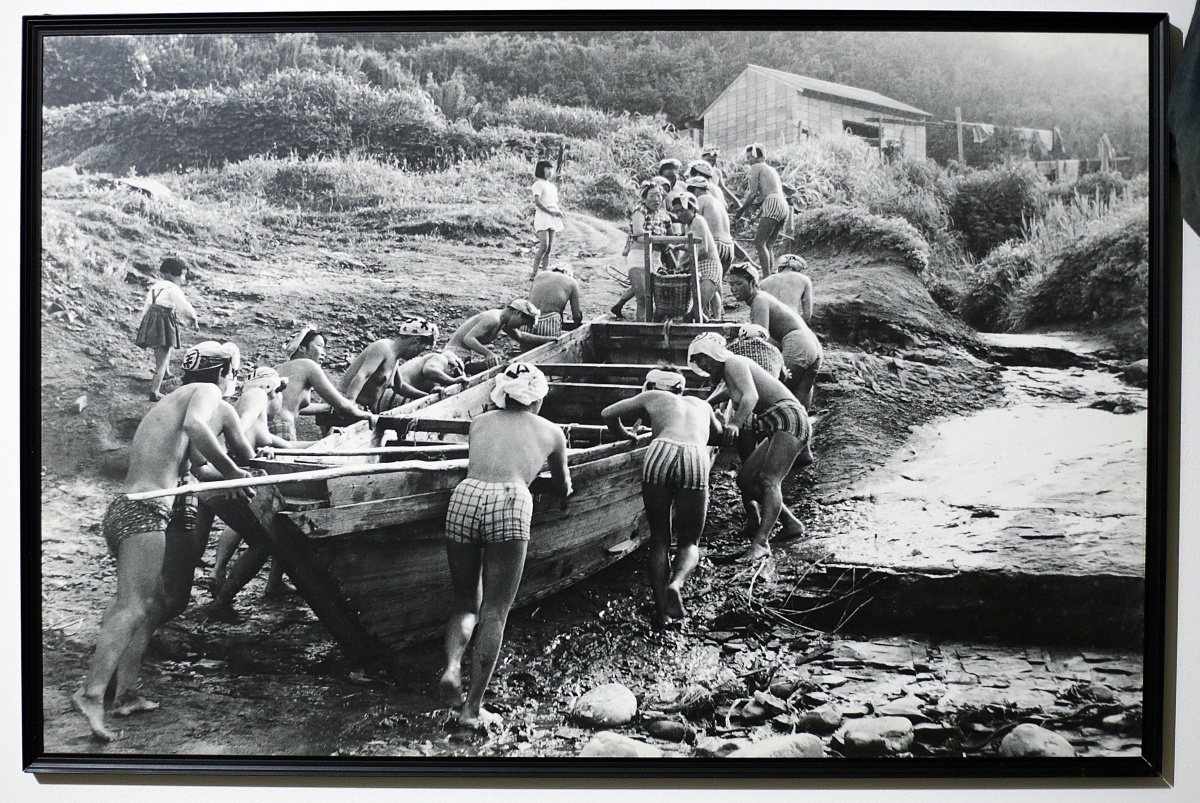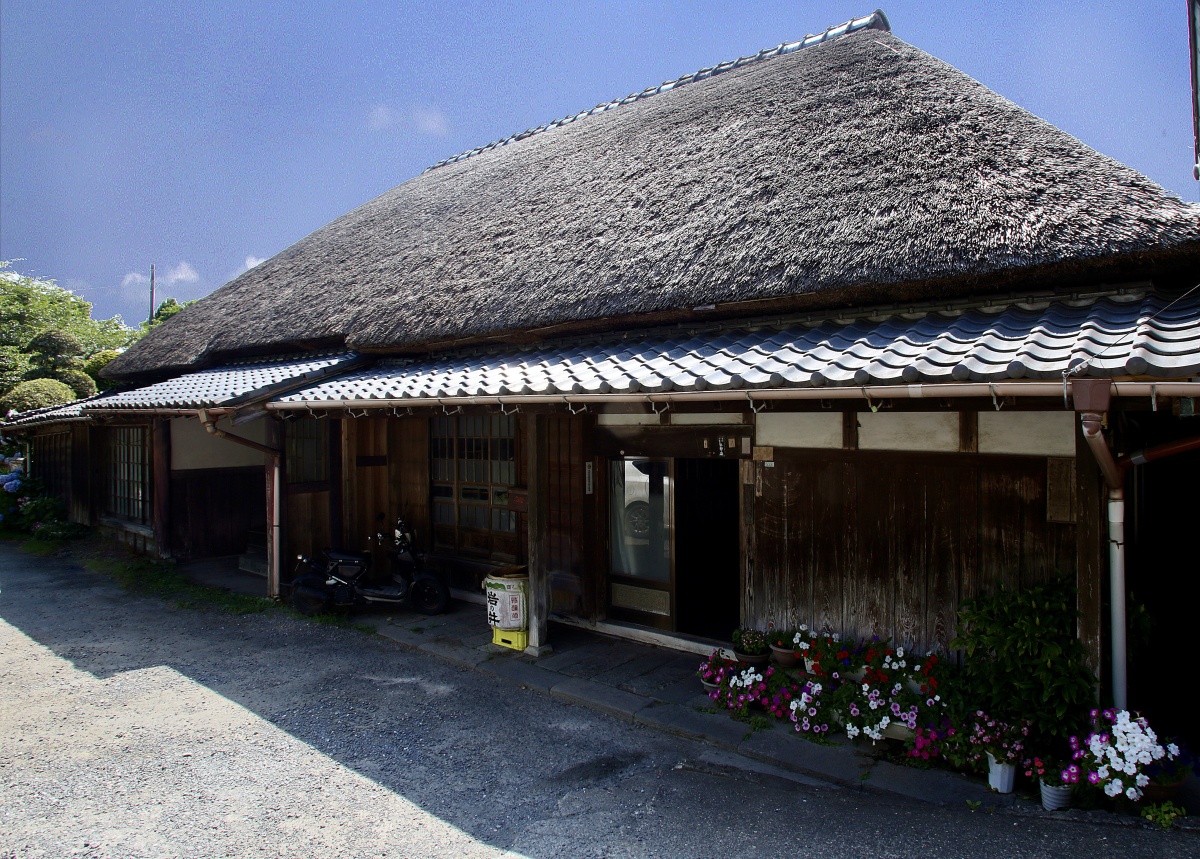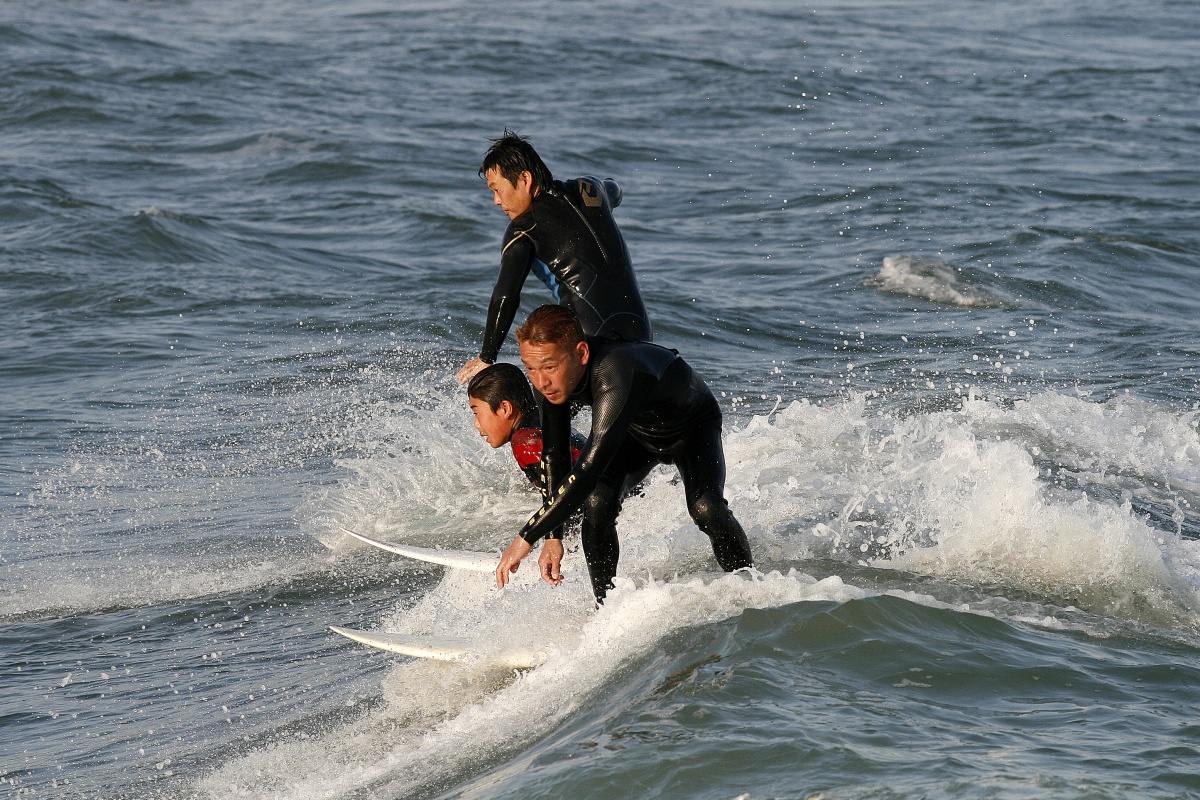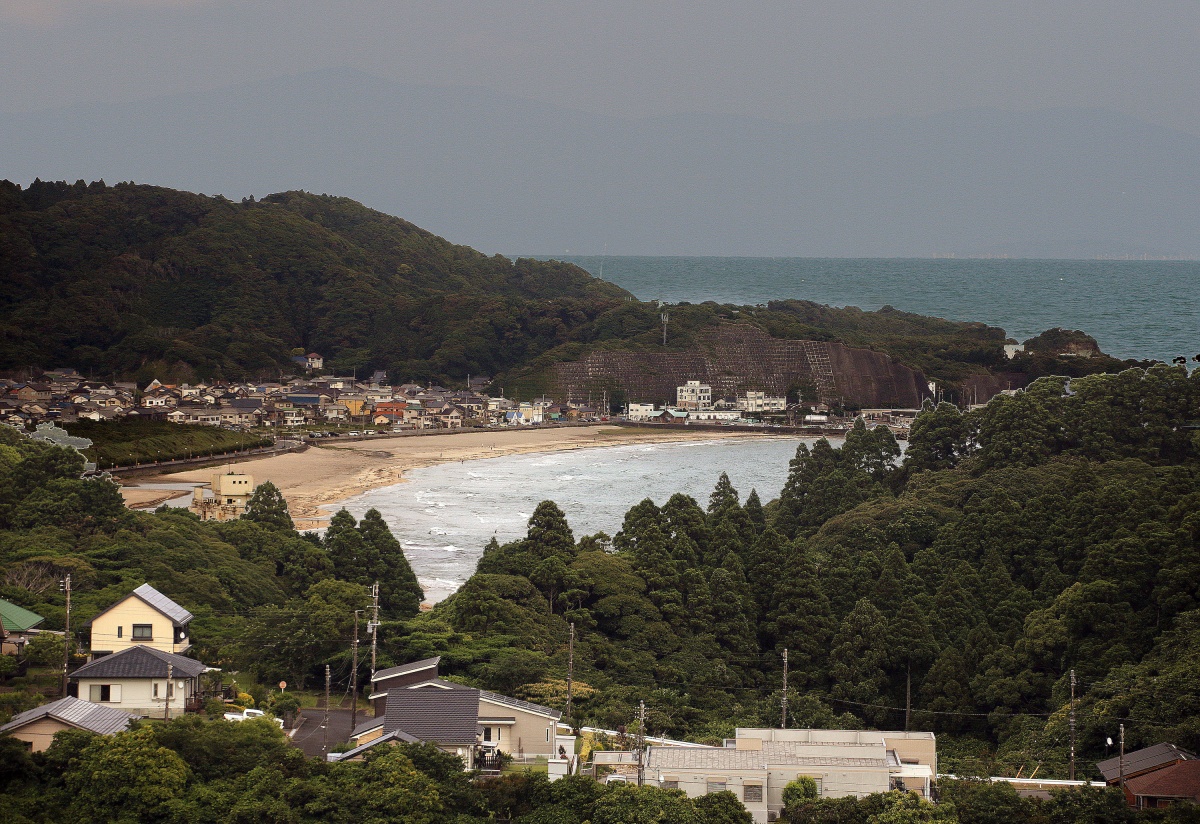Chiba's Secret: Unspoiled Beaches and Lush Forest Hills
Chiba's Pacific coast is known for fine beaches, and the little village of Onjuku has one of its best.
You probably think it requires a long trip to some distant corner of the archipelago to reach the green, unspoiled Japan of your dreams, Well, here’s a secret that few visitors, even veterans, have yet to discover: not far out the back gate of Narita Airport is one of Japan’s most beautiful, natural areas. John Harris (text) and John Lancaster (photos), both residents of Onjuku, share their insights.
By John R. HarrisJust minutes beyond Narita’s Gate 6 is a maze of quiet country lanes that wind past ancient farmhouses and lush forests. Go a bit further, 20km from the airport, to reach Kujukuri, Japan’s longest beach. There, turn right and head 25km south to where thickly forested hills meet the Pacific Ocean.
Here begins the 70km-long Boso Peninsula. Its Pacific coast is bordered by some of Japan’s best surf beaches, while its hilly center is carpeted by the nation’s largest remaining contiguous lowland forest, teeming with wildlife. Sinuous valleys in between hold farms and hamlets little changed by time, along with a bizarre assortment of human endeavors, from counter-cultural communes to a retirement home for circus elephants . . . and my home.
Onjuku, Welcoming Overseas Visitors Since 1609

Next to the local sake brewery is a delightful gallery of photos of the area's ama-san, the women divers who's ancestors saved the crew of a Spanish galleon in 1609.
The first foreigners to visit my little town on Boso’s Pacific coast (Onjuku, pop. 7,000 and dropping) arrived by accident. On the night of September 30, 1609, a Spanish galleon en route from Manila to Acapulco was dismasted in a typhoon, and ran aground on our reef. When the 300 villagers awoke to spot the fractured hulk offshore, the womenfolk were dispatched to swim out and investigate.
Why the women? Well, then as now, local livelihoods revolved around abalone and rock lobster, seafoods that could only be harvested by diving deep to pick them. And since women are better suited to free-diving than men, this was women’s work. Known as ama-san, by tradition they worked near naked, right up to the early 1960s.
Our ama-san managed to rescue 317 of the 373 shipwrecked marineros, including the colonial governor of the Philippines, Mexico-born Don Rodrigo de Vivero. Local legend has it that they warmed the hypothermic sailors with their bare bodies. One can imagine the effect that must have had!
At Mexico Park, a column commemorates the 1609 shipwreck and the sculpture "El Abrazo" celebrates the local legend that the ama-san warmed the sailors with their bare bodies.
Inaugurating our town’s long history of international hospitality, the Mexicans and Spaniards stayed for a month, doubling the local population at a time when food was quite scarce. They were then packed off to Edo, where the recently installed Shogun Ieyasu Tokugawa (of TV Shogun fame) lent them a Western-style ship built for him by the Englishman William Adams (the navigator of the TV series).
For centuries thereafter, Onjuku reverted to near-complete isolation from the rest of Japan. Ringed by steep, rugged slopes, the only way in or out, apart from narrow forest paths, was by boat. Early photos look more like Polynesia than Japan.
Change finally reached our little town in July 1913 when the Sotobo Railway opened to Onjuku Station, following the completion of numerous tunnels along the coast. Not long after, the town’s historic role was rediscovered as Japan and Mexico moved to solidify their diplomatic relations in the 1920s. To celebrate this link, and relations with Spain, an imposing monument was built on a hilltop overlooking the wreck site.
Today, almost everything magnifico from Mexico that comes to Japan visits Onjuku: musical groups, baseball stars, presidents and even Cuauhtemoc, the Mexican navy’s tall ship (that sadly struck the Brooklyn Bridge recently).

More than four centuries old, the frame of this thatched building at the Iwanoi sake brewery includes timbers salvaged from the 1609 shipwreck.
Apart from the Mexico Monument, Onjuku offers other vestiges of the relationship. The main street from the station is Lopez-Portillo-dori (named for the Mexican president who in 1978 helicoptered in for a 30-minute visit), which leads to the Casa de la Amistad México-Japón. Open weekends only, it is a labor of love by violin maestra Yuriko Kuronuma (who taught generations in Mexico City over 40 years). It houses a vast collection of Mexican violin figurines.
Not far away, hidden away in a quiet corner of the town center, is one of my favorite spots: our local sake brewery, Iwanoi, founded in 1723 and headed by Yoshikazu Iwase, the 11th of his family line. His father, Sadayuki Iwase, was also a photographer who documented Onjuku’s ama-san from the 1930s through the early 1960s when they finally threw in the towel. The thatched-roof main building is so ancient that its roof beams are made of lumber salvaged from the Spanish galleon. Next door is a former hospital that features a delightful gallery of ama-san photos. Let yourself in, don slippers, turn on the lights, peruse the photos and sign the guestbook on your way out. This little known gem is the best thing in town
Hollywood has its sign. Onjuku has ours.
Surf's Up!

The beach at Onjuku is a magnet for surfers, many of whom drive overnight to spend the day on the waves.
Beyond a stretch of condos lies Onjuku’s pride and joy, our 1,500-meter-long beach which many believe has the finest white sand in eastern Japan. Surfers flock here year-round. Several locals, including Hawaiian pro surfer Eugene Teal, can teach anyone interested. During peak swimming season, mid-July to September 1, the strand is pleasantly thronged and thonged. Its umi-no-ie (seasonal beach bars) are famed as the starting venue for many short-term summer romances.
Every day except Wednesday since 1591, Katsuura's morning market has offered fresh fish and vegetables.
The sign reads: I've just returned from India: Ice Chai ¥200 (¥250 with a cookie), Mango Lassi ¥250.
The fishing port has two fine sushi-ya, Tanaka and Kanehachi, plus the delightful Club Zero gastro pub, and a dozen or so informal eateries catering to beachgoers. For a uniquely Onjuku treat, Kikyo-an, our artisanal soba restaurant, features the venison of locally hunted kyon (more on them below).
If your accommodations come with a kitchen, stock up on groceries at Ohtaya, our small but well-stocked supermarket, or one of several neighborhood fishmongers. Fresh local vegetables abound year-round. Our two next-door towns, Isumi (north) and Katsuura (south), offer even more options. Katsuura is my go-to favorite for its morning market–operating since 1591!–with freshly-landed fish and local vegetables. Even more magnetic for me is Spaice Coffee, a hole-in-the-wall espresso joint run by Konno-san, my pal since he started out selling coffee from a cart pulled by bicycle. Just round the corner is Maison Aya bakery, with baguettes et croissants that our local French residents swear are as good as at home. And for me, no visit is complete without dropping into Liam & Brooke’s, the vintage clothing store run by a young Scots couple.
But enough about towns. It’s the surrounding forest that really matters to me.
Forest Bathing

The forest begins just behind the last houses of Onjuku.
Shinrin yoku, “forest bathing,” is the Japanese belief that health benefits are to be had just from immersing yourself in a living, breathing forest environment. There are few places you can get a better dose of it than in our forest that starts just behind Onjuku.
I live in the heart of it, surrounded by critters of all sorts: wild boar (big nuisance but delicious), kyon (invasive type of mini-deer, also delicious), badgers, tanuki (so-called raccoon dogs), North American raccoons (don’t get me started on how they got here!), civet cats, moles and more. Also, three kinds of snake (two venomous) and an amazing range of avian life. At night I’m lulled to sleep by the hoot of owls.
Since we only get the odd light frost in winter, palm trees grow here. Something blooms every month of the year: in January, a blaze of red winter camellias; April 1 sees a sea of pink cherry blossoms; May, a shock of purple azaleas; in our June rainy season, firework bursts of hydrangeas.
Before road tunnels were dug in the 1950’s and ‘60s, the only way to get around was over the hilltops and along the ridges so there are many forest trails, some the sites of fierce battles between Boso’s two rival samurai clans. Today, as most of the entry points are hard to find, finding your way into the forest can be challenging, especially since the up/down trails tend to wash out. But once you reach the ridgetops you can often hike for hours. Best times for forest hikes are winter, spring and late autumn once the undergrowth subsides.
Perhaps the most accessible is the track to Koura Kaigan (a gorgeous hidden beach). The entrance is just past the marine biology lab, 1km north of Mexico Park.
If you’re not into full-on bushwhacking, there are pleasant strolls to be found along narrow back roads lined with charming rustic farmhouses, shrines, temples and other delights. The main thing is to avoid heavily trafficked roads and their many tunnels. Bicycling is great, but get good maps and plot your routes carefully. To avoid main roads and exhaust belching trucks, look for paved paths through the rice paddies. Onjuku’s tourist office will rent you a bike for ¥1,200/day.
Where to Stay?
The Ocean View House in Isumi can accommodate up to 12 guests in its 4-bedroom, 1 bath sprawling layout. Complete with garden barbecue, it's only a 3-minute walk to the sea.
Onjuku has a range of accommodations that is growing, from glamping and Airbnb options right up to ocean-view mansions fit for a cartel drug lord. While beds can be pricey and scarce during peak beach season (roughly July 15 to September 1), off-season and mid-week alternatives abound. Even if you haven’t booked online ahead of time, you can wander into the tourist office next to the train station and the staff will usually find you something. Although helpful they only speak Japanese.
Sayan Terrace, our ‘fancy’ hotel, is luxurious enough that Japan’s Crown Prince (now the Emperor) stayed in one of the lovely ocean-view rooms in 2009. Nowadays though, the most luxurious accommodations are short-term rentals tucked away in secluded coves up and down the coast. For both stunning setting and value (4 guests @ ¥10,000/night each + cleaning fee), my favorite is the Ocean View House hosted by Czech artist Pavel Bednar and his TV director wife Eiko.
Inland and in-town options are more affordable, especially one-bedroom flats in the beachfront high-rise buildings. Another alternative are several traditional vacation hostelries that offer both meals and rooms. Hamayoshi, hosted by Kaizuka-san, is one of the better ones.
For “glampers,” The Bonds is close to the beach, and features dome rooms, saunas and hot-tubs. I favor Planet Camp Field, because you can have a real campfire (and because the host, Suzuki-san, grows the rice I eat). Another great forest campsite is Jikkoku Auto Campground, sited on the edge of some of our best forest hiking.
Come for a Day, Stay for a Month
This monument was erected by the city council to welcome a visit by José López Portillo, the president of Mexico, in 1978.
From Tokyo, Onjuku is a wonderful spot for a day at the beach–less than 90 minutes from Tokyo Station by express train. It’s a little more than that from Narita, making it a great spot to lose your jet lag.
But it’s an even better place to kick back and relax for a week or a month: to read deeply, take long walks, learn to surf, make friends with the locals, explore this amazing peninsula . . . or even write a book. Japan doesn’t need to be a frantic Instagram marathon. If you want to slow down and let this amazing country seep into your soul, Onjuku is a great place to do it.



